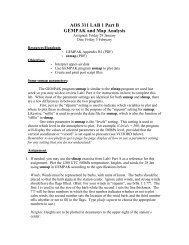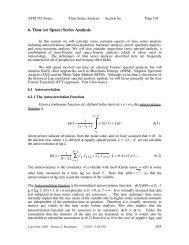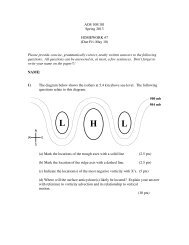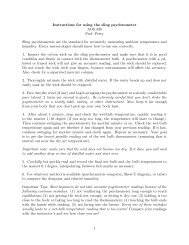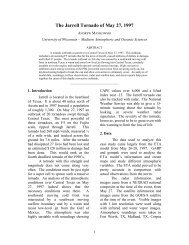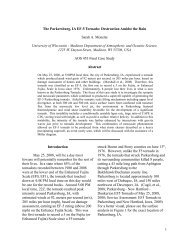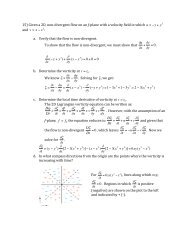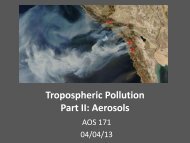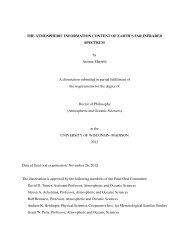1 Lab 11 - AOS 330 More Meteorological Measurements and ...
1 Lab 11 - AOS 330 More Meteorological Measurements and ...
1 Lab 11 - AOS 330 More Meteorological Measurements and ...
You also want an ePaper? Increase the reach of your titles
YUMPU automatically turns print PDFs into web optimized ePapers that Google loves.
<strong>Lab</strong> <strong>11</strong> - <strong>AOS</strong> <strong>330</strong><strong>More</strong> <strong>Meteorological</strong> <strong>Measurements</strong> <strong>and</strong> Observations1 Objectives• Learn to use a sling psychrometer to measure dry-bulb <strong>and</strong> wet-bulb temperature.• Learn to convert the above measurements to dewpoint <strong>and</strong> relative humidity.• Introduction to sky, visibility, <strong>and</strong> present weather observations.2 Materials <strong>and</strong> Equipment• Sling psychrometer with built-in slide rule• Bottle of distilled water• Thermodynamic diagram (e.g., Skew-T)• Psychrometer h<strong>and</strong>out• Norm<strong>and</strong>’s Rule h<strong>and</strong>out• Humidity table3 Part I3.1 IntroductionTemperature <strong>and</strong> humidity are important not only because they have a strong effect onhuman comfort, agriculture, etc., but also because of their importance for atmosphericdynamics <strong>and</strong> energetics. Without temperature differences, there would be no pressuredifferences <strong>and</strong> thus no wind. Without atmospheric moisture there would be no clouds orprecipitation.3.2 FundamentalsThere are a variety of devices for automatically measuring both temperature <strong>and</strong>humidity. However, the simplest <strong>and</strong> most reliable st<strong>and</strong>ard method is the slingpsychrometer. This instrument consists of two mercury thermometers, one of which has amoistened bulb. The sling psychrometer is gently twirled to ventilate both thermometers.Other types of psychrometers use fans to ventilate a pair of thermometers in a fixed orportable housing. The dry-bulb thermometer measures the actual air temperature; the wetbulbthermometer generally measures a somewhat lower temperature on account ofevaporation of moisture from the wick. The humidity of the air determines the rate ofevaporation <strong>and</strong> thus the degree to which the wet-bulb temperature is depressed belowthe dry-bulb temperature. When the relative humidity is high, the difference is small;when the air is very dry, the difference can be large. There is a variety of ways to convertthe raw wet-bulb <strong>and</strong> dry-bulb measurements to something more useful, like relativehumidity <strong>and</strong>/or dewpoint. We will use three different methods.3.3 Procedures1. Before going onto the roof, carefully read the h<strong>and</strong>out instructions for using the slingpsychrometer.2. Once on the roof, find a spot in a shady area but with adequate exposure to the breeze(if present). Moisten the wet-bulb thoroughly with distilled water. Observe the dry-bulb<strong>and</strong> wet-bulb temperature. Record your values to the nearest 0.1 degree (you will have to 1
estimate by interpolating by eye between the tick marks). When you are finished withyour own measurement,3. Tell the instructor what your wet-bulb <strong>and</strong> dry-bulb readings were. If they differ toomuch from what he/she thinks you should have gotten, he/she may ask you to repeat themeasurements. Hint: The most common error is that your wet-bulb temperature will betoo warm for any of several possible reasons (not exposed long enough, bulb too dry,etc.).4. Estimate the relative humidity <strong>and</strong>/or the dewpoint, using each of the followingmethods:• Thermodynamic diagram (dewpoint <strong>and</strong> relative humidity)• Table (relative humidity only)• Humidity slide rule (relative humidity only)5. Record your results in your lab writeup. If there are large differences between yourresults obtained using the different methods, then go back <strong>and</strong> check your procedure.Differences in dewpoint should be no more than a degree or two. Differences in RHshould not exceed a few percent. 2




